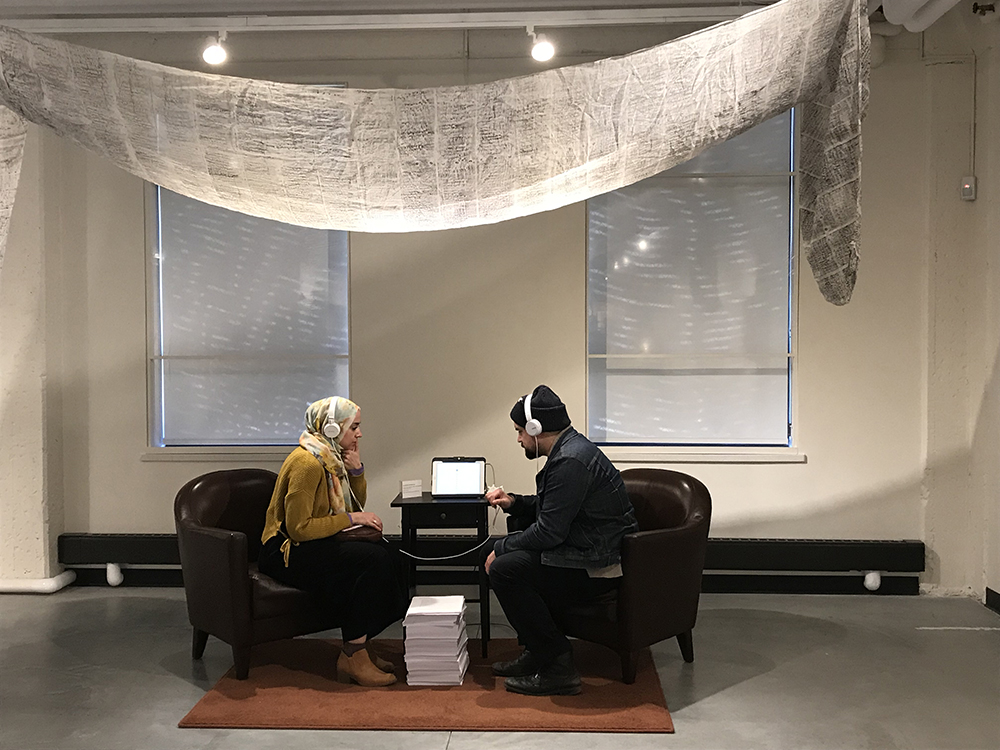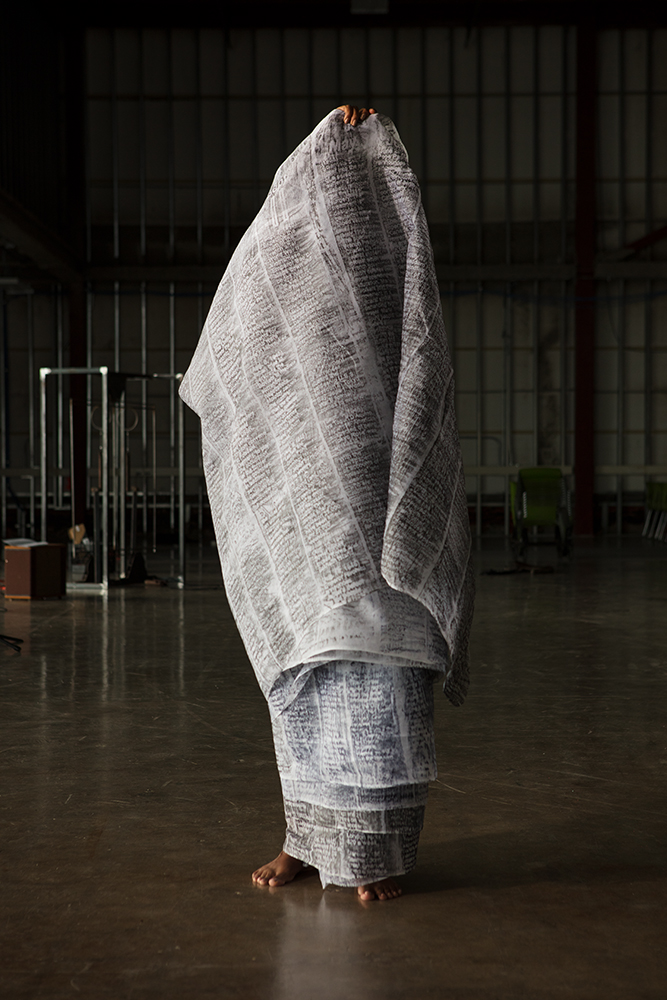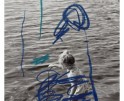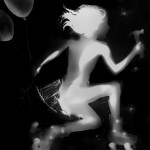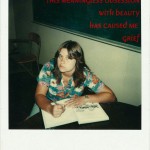On Collaboration: On Belonging by Nirmal Raja and Lois Bielefeld

©Nirmal Raja and Lois Bielefeld, Best Food Indo-Pak Groceries-Sari 34. 2018, From Reaching through 5 ½ yards, 8497 miles
Responding to increasing racial polarity in the United States, interdisciplinary artist Nirmal Raja and photographer Lois Bielefeld have launched two collaborative projects, reaching across race lines to explore identity, place, and belonging. Their initial project, Reaching Through 5 ½ yards, 8497 Miles, examines the role of cultural markers and our visual understanding of race.
Raja emigrated from India for her education and Bielefeld is a Milwaukee, Wisconsin native and identifying with the queer community. With xenophobia and racism on the rise, the artists felt compelled to examine how initial perception of the ‘other’ occurs. Though living in the United States for the past 28 years, Raja rarely wore her cache of 150 saris due to both internalized social pressures and practicality. In the photographs, she dons her native garment, performing an act of resistance against conformity and reclaiming the right to look different and yet belong. As Bielefeld documents, they traverse both mundane and institutional places of power, examining Milwaukee as place and as a stand-in for a broader, Midwestern demographic.
This project spawned another — What is recorded | What is remembered which includes still photographs, a video performance, a 3 channel video installation, and an audio archive. Responding to an engraved timeline of Wisconsin and America’s history on Milwaukee’s Riverwalk, the work questions the veracity of recorded history and attempts to contend with it. Raja made a rubbing of sections of this timeline on 30 meters of fabric which became a prop for performance-based photo and video works that bring attention to our fraught relationship to history. Ritual actions are performed in the videos, through which history is visualized as a membrane that connects, divides, filters and binds.

©Nirmal Raja and Lois Bielefeld, Bombay Sweets- Sari 35. 2018, From Reaching through 5 ½ yards, 8497 miles
Current racial polarity was the catalyst of this project. So Nirmal, as an interdisciplinary artist, what made you decide on a making this work a photographic collaboration, rather than a commission or using a photo assistant?
Nirmal:
The results from the 2016 elections were deeply disturbing to me. I was visiting family in India while the new president was sworn in and when I came back, the country felt palpably different. I started questioning the role of my work and what citizenship meant to me and felt a deep urge to respond to the increasing xenophobia that was and is increasing in this country. Out of this questioning came an idea that demanded strategies of performance and collaboration. I reached out to Lois to see if she would be interested in collaborating with me in making pictures that document me traversing the Milwaukee landscape, while wearing my many saris – visibly different. This simple act of articulating difference became a way I could resist homogeneity and straddle my two identities- South Asian and American. Although this is a simple enough idea in concept, I knew that I did not want to commission a photographer. It needed to be a conversation and a collaboration with another artist who grew up in Milwaukee and a photographer with a firm understanding and experience in capturing the essence of the Midwest. Someone who is willing to join me on this journey of investigation and make something together that is stronger than what either of us would have made on our own. The photographic medium was a natural, even necessary choice due to its inherent political ties and its perceived veracity. The documentarian quality gave the work its strength as we were shooting in varied locations with little control of what is in the frame. The work is also about the simple act of looking- how we see others and how others see us and confronting the audience with the complex question of who is American and who belongs.

©Nirmal Raja and Lois Bielefeld, Bradford Beach- Sari 01. 2017, From Reaching through 5 ½ yards, 8497 miles
Lois, you mention your solo work is “highly-curated” which requires personal control, what made you enter into this collaboration?
I too was processing the disturbing shift transpiring across the nation. Being queer my rights under this administration potentially could change- in fact for my trans friends they already have. Furthermore, the undercurrent of fear and othering has affected me and my community. I felt this deep call to action and was questioning my practice and its relevance. When Nirmal reached out it was exactly what I needed. Through collaboration we explored belonging and the visual understanding of identity during this fraught time.
My work predominantly has been staged portraits around a central theme, such as mealtime or gender. Most recently I’ve been working on two bodies of work Celebration and New Domesticity where the photographs have become highly-curated and process-oriented. In 2017 when first discussing the project Nirmal and I both were really open to how things would evolve and take form. I think it was this openness to test different methods and processes that made our collaboration seamless. We did entertain the idea of doing highly-curated portraits of Nirmal in public spaces. Yet after testing together and examining the results we found the orchestration of Nirmal performing within each place was enough to create these really interesting scenarios that pushed against documentary photography. Walking this line of documentary and performance I was pushed out of my comfort zone of staging, creating and controlling the light, and having permission from subjects. Relinquishing control was a huge part of this collaboration for me. Rather I had to pay attention, wait for serendipity, and allow strangers to activate and create a dialogue through movement and action within the frame in conjunction to Nirmal.

©Nirmal Raja and Lois Bielefeld, Milwaukee Women’s March- Sari 40. 2018, From Reaching through 5 ½ yards, 8497 miles

©Nirmal Raja and Lois Bielefeld, Downtown Department of Motor Vehicles- Sari 48. 2018, From Reaching through 5 ½ yards, 8497 miles
What control or autonomy did each of you relinquish? What did each of you gain from the collaboration?
Nirmal: This is the most courageous work I have ever made. It required trust in my collaborator as I was putting myself in a subject position that was vulnerable to misrepresentation. Lois and I established trust in each other right from the beginning. The support that I obtained from her was really essential for me as I felt overexposed while shooting in public spaces.
This work is also very different from anything I have done in my art practice as my hands were not literally engaged in the act of making. The tactile and visceral aspects of my studio practice became mediated through the camera instead of my hands.
Lois’s generosity in sharing her work process led to a lot of learning and a peek into how a photographer experiences the world through her lens. Female kinship and shared strength across racial boundaries led to an exchange of ideas and a wonderful friendship.
Lois: Through collaboration I was privy to seeing Nirmal’s rich practice- her aesthetic, her interdisciplinary approach to each idea, and how she explores concepts through rigorous research. Having a collaborator meant having a sounding board to discuss every aspect of the work both in the actual making but also the larger ideas and issues at stake. I learned immensely from my discussions with Nirmal and I’m incredibly grateful for this. I also think there is a curious osmosis that occurs with collaboration- an imprinting of aesthetics that flows both ways. Lastly for both of us this work was uncomfortable to make. Photographing in public spaces without permission literally made me feel sick to my stomach yet I found strength from Nirmal knowing we were in it together.

©Nirmal Raja and Lois Bielefeld, Downtown- Sari 18. 2017 , From Reaching through 5 ½ yards, 8497 miles

©Nirmal Raja and Lois Bielefeld, Sikh Temple of Wisconsin- Sari 55. 2018, From Reaching through 5 ½ yards, 8497 miles
How did you edit this work together in terms of photographic criteria and content? in terms of politics and performance? How did this process come to define your collaboration?
We had a specific agenda about exploring different places in Milwaukee, both public and personal spaces. We created a Google document with a list of places that define Milwaukee such as landmarks, places of governance, places of worship and also domestic places with personal histories. This list became the defining factor in our collaboration and subverted the idea of Milwaukee as one of the most segregated cities in the country. We were comprehensive in our approach but also pointed in our intent while discussing the content and history of a place. The choice of what sari to wear in any given space was a formal one that we made together. The final edit was determined through discussion of gaze and formal strength of the image. Whether the gaze was on camera or off was a constant factor we had to contend with as gaze played a very strong role in the narrative of the image. The serendipitous moment captured by any given frame sometimes became a determining factor of an edit.
The work is inherently political. The sari is a stand in for any cultural garment like the hijab or the Sikh turban that overtly identifies difference. Wearing such a garment in spaces where we exercise citizenship was an act of occupying space in the midst of a homogeneous landscape. Some of the most important images in this realm were the polling place, the women’s march, the DMV, places of worship, places with civil rights history like the Father Groppi Bridge and social and political history like the Milwaukee Public Museum.

©Nirmal Raja and Lois Bielefeld, Milwaukee Public Museum, Sari 49. 2018, From Reaching through 5 ½ yards, 8497 miles

©Nirmal Raja and Lois Bielefeld, Petrou Eye Care- Sari 37. 2018, From Reaching through 5 ½ yards, 8497 miles
Please explain how Reaching through 5 ½ yards, 8497 miles spawned What is Recorded | What is Remembered and beyond…
Lois: A public project down the road from where Nirmal lives became the trigger for What is Recorded / What is Remembered. The Milwaukee River Walk has a timeline of Wisconsin and American history engraved on its boardwalk. Nirmal was planning to do a rubbing of sections of this timeline on a thirty meter piece of white fabric. I decided to document this act of rubbing and we discussed producing performance based photographic works where this fabric would be a prop and a metaphor for history. We discussed history also as a “place” where women and people of color were often invisible or misrepresented. The twelve photographs we eventually produced expressed the conflicting emotions that each of us experience with regards to history- how we sometimes want to embed ourselves in it and how we sometimes want to reject or change it. The initial idea of performance based photographs quickly expanded to include varied voices and participation of women from the community in a 3-channel video installation and audio archive. We were filled with curiosity to learn from women with varied backgrounds and experiences about how they perceived history and their place in it.
Nirmal: We all come into this world in the midst of a timeline but this is felt more deeply when one is an immigrant, having to claim the history of the adopted country as one’s own. I want to embed myself in America’s history but also reject its more violent and racist past. These conflicting emotions are expressed in the suite of performance based photographs that are part of What is Recorded | What is Remembered. The project then took on a life of its own like a pebble creating ripples in water, moving outward and larger. We created space and visibility for women with diverse backgrounds from the Milwaukee community. The process of working with these women, through performing together or having in depth conversations with them regarding American history and the current state of the country was incredibly rewarding.
What is Recorded | What is Remembered. 2019; Collaborative work by Nirmal Raja and Lois Bielefeld from Lois Bielefeld on Vimeo.
Can you reflect on collaboration as a model for resolving some of the issues you are examining?
Nirmal: The work simply would not be what it is without the two of us working together. We played to each other’s strengths, exchanged new ideas and traversed unfamiliar places. We examined identity and place while coming from different races and backgrounds, finding kinship and strength, empathy and knowledge. Through both projects, we connected with each other and so many others, listening to stories of struggle and diverse perspectives. I gradually began to feel more connected with the larger community-the ultimate and most important result of this project for me.
Lois: I never would have felt that these were topics (migration and race) that I had agency to discuss through my practice. Being a queer white woman I do understand being othered and this provided my own entry point. It is so important to me to respect someone to tell their own story. Nirmal extended access through our collaboration to discuss immigration and race outside of my whiteness. I regularly think about photography in regards to representation, agency, and how I situate as an artist within a photographic conversation. So for me I gained access to discuss really important and fundamental ideas of belonging through this collaboration.
Lois Bielefeld uses series-based portraits, filmmaking, audio pieces, and installation to capture those human moments and qualities that both bind us and display our uniqueness. These social studies center on food, identity, gender, community, and personal space. Bielefeld currently resides in the San Francisco Bay Area. Bielefeld is represented by Portrait Society Gallery.
Website: www.loisbielefeld.com Instagram: @loisbielefeld
Nirmal Raja is an interdisciplinary artist whose work deals with concepts of displacement and cultural negotiation. Notions of temporality, memory and change as related to these overarching themes are explored through extensive experimentation with materials and processes. Raja currently resides in Milwaukee, Wisconsin.
Website: www.nirmalraja.com Instagram: @nirmal.raja
Posts on Lenscratch may not be reproduced without the permission of the Lenscratch staff and the photographer.
Recommended
-
Amy Lovera in Conversation with Douglas BreaultJanuary 23rd, 2024
-
Brittany Marcoux in Conversation with Douglas BreaultJanuary 22nd, 2024
-
Penumbra / Image Threads LTP: Adam Meeks and Raymond Meeks in ConversationSeptember 9th, 2023
-
Penumbra Foundation / Image Threads LTP: Again and Again: Ruth Lauer-Manenti and Evan Davis in ConversationSeptember 7th, 2023
-
Penumbra Foundation / Image Threads LTP: Atefe Moeini and Shahrzad Darafsheh in ConversationSeptember 5th, 2023

